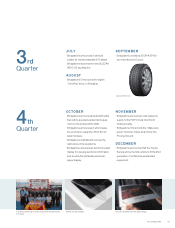Bridgestone 2009 Annual Report Download - page 20
Download and view the complete annual report
Please find page 20 of the 2009 Bridgestone annual report below. You can navigate through the pages in the report by either clicking on the pages listed below, or by using the keyword search tool below to find specific information within the annual report.CORPORATE GOVERNANCE, COMPLIANCE,
AND RISK MANAGEMENT
APPROACH TO CORPORATE GOVERNANCE
Continually enhancing corporate governance is viewed as one
of management’s most important focus points; this will ensure
that the Bridgestone Group continues to fulll its founding
mission as stated in its corporate philosophy: “Serving society
with superior quality.”
OVERSIGHT AND OPERATIONAL EXECUTION
In accordance with the responsibility and authority delineated in
the Administrative Authority Rules, as well as in the Policy
Management Rules, Bridgestone Corporation is committed to
developing, communicating and abiding by fair, transparent
decision-making and management policies.
Bridgestone has adopted a corporate ofcer system to more
clearly distinguish between management and operational
responsibilities. This system allows the Board of Directors to focus
more effectively on overseeing the execution of business
operations. There were 9 directors as of December 31, 2009.
To take steps to strengthen corporate governance, such as
further engaging the Board of Directors, at the General Meeting of
Shareholders held on March 30, 2010, 8 directors were elected,
including 2 new outside directors.
INTERNAL AUDIT FUNCTION
Bridgestone employs a corporate auditor governance model as
specied in the Companies Act. The corporate auditors audit the
execution of duties by the directors, while the Board of Directors
oversees the execution of duties by the directors. As of December
31, 2009, the Board of Corporate Auditors had six members,
including three outside auditors. To prepare for a possible vacancy
where the number of corporate auditors might fall below the
minimum requirement stipulated by the Act, one substitute
corporate auditor was elected at the General Meeting of
Shareholders held on March 30, 2010.
The corporate auditors conduct internal audits based on
policies determined by the Board of Corporate Auditors. Directorial
conduct oversight involves a number of auditing activities,
including attending meetings of the Board of Directors and other
executive meetings, interviews with directors to ascertain the
status of operations, reviews of important business documents,
and on-site audits of business ofces.
Moreover, the corporate auditors meet with the representative
directors to exchange information and opinions and hold liaison
meetings with the corporate auditors of major Bridgestone
subsidiaries in Japan. A dedicated support staff unit assists the
corporate auditors.
The Internal Auditing Ofce and internal auditing departments
within the Company’s divisions and major subsidiaries conduct
internal accounting and operational audits. The Internal Auditing
Ofce makes annual audit plans and conducts on-site audits of
each function, division, and subsidiary. It employed 24 people
(excluding those working concurrently in other positions) as of
December 31, 2009. The Internal Auditing Ofce and the
Company’s internal auditing departments have conducted audits
at Group companies that have instituted organizational changes in
line with the provisions of the Act, with the aim of ensuring a more
robust internal control system.
INDEPENDENT FINANCIAL AUDIT
Deloitte Touche Tohmatsu LLC, performs the independent audit
of the Company’s nancial statements. The independent nancial
audit team in scal 2009 included 3 certied public accountants,
12 assistants who were certied public accountants, 8 associate
members of the Japan Institute of Certied Public Accountants,
and 7 other staff members. The corporate auditors, the Internal
Auditing Ofce, and the independent auditors exchange information
and opinions as necessary and generally maintain close contact,
thereby working to increase audit efciency and effectiveness.
CORPORATE GOVERNANCE STRUCTURE
The Executive Operational Committee is a senior management
body that operates in a consultative and deliberative capacity to the
Board of Directors. It is chaired by the CEO and President and is
composed of directors, corporate ofcers, and divisional heads*. It
is a forum for discussing and reporting on specic matters set forth
in Company policy as well as other important matters. Nominees
for executive appointments and executive compensation packages
for all directors and corporate ofcers are determined by the
Directorial Personnel and Compensation Committee.
Selected directors (excluding the CEO and President),
corporate ofcers, divisional heads, and corporate auditors serve
on this committee. Nominations, executive compensation, and
other ofcer-related matters are all within the purview of this
committee. Matters considered and reported by this committee
are reviewed before a decision is made by the CEO and President,
the Board of Directors, the Board of Corporate Auditors, or the
General Meeting of Shareholders. This helps to ensure
transparency and objectivity.
*also titled directors (non board members) within Bridgestone, “Honbuchou” in Japanese
18 Bridgestone Corporation






















